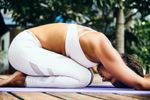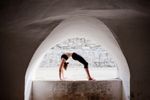This routine is like caffeine for your spirit. Do it first thing in the morning to supercharge your day.
Starting your day with yoga creates a bridge between resting and doing. A yoga sequence like the one below helps you integrate the clarity that comes from a good night’s sleep with the powerful potential awaiting ahead. It's worth rising a little earlier to fit it in!
Use it to awaken your body and energize your mind. One note: These GIFs move quickly to show you the transitions, but do the poses at your leisure — there is no need to rush. Yoga reminds us to slow down, observe and course correct in order to move mindfully in a chosen direction. This sequence can act as a springboard for personal discovery if you take your time, tune in and don’t force anything.
1. Cat-Cow Warm-Up
Cat Pose (Marjaryasana)
- Come to your hands and knees and round your back into flexion, arching like a cat. Gaze up-and-in towards the naval.
Cow Pose (Bitilasana)
- Flow into the inverse with the spine in extension. Keep your hands under the shoulders, knees under the hips, and the abdominal wall engaged. Gaze forward and down over the nose.
Cat-Cow Circles
- Inhale into Cow Pose, and exhale into Cat Pose. Begin your practice going back and forth between these postures a couple of times.
- Then you can begin to play — make circles, do side-bends or make figure-eights with your spine. The point is to explore what feels good to you. I like to make circles leading with my head and neck, which I find relieves a lot of neck and shoulder tension.
- Rest in a child’s pose or downward dog for as long as it suits you.
2. Standing Side Bends
Parsva Urdhva Hastasana (Upward Saluting Side Bend)
- Come to stand in Mountain Pose with your big toes touching. Lift your arms overhead.
- Grab your left wrist in your right hand with your palms facing up towards the ceiling.
- Side bend as far as you can to the right.
- Press down into the heel of your left foot, as you reach out through the heel of your left hand, and breathe smoothly as you feel the entire left side of your body lengthening from heel to heel.
- As you focus your mind, feel as though you are pulling back on a slingshot. What higher purpose are you aiming for?
- After a minute of breathing and focusing here, exhale deepen the pose just a touch, and then inhale come back up to center.
- Repeat on the other side.
3. Standing Twists
Thunderbolt Pose (Utkatasana)
- Come to stand in Mountain Pose. Bend both of your knees deeply, and touch your fingertips to the floor in front of your toes. That’s how much flexion I want in your ankles, and how deeply I want you to bend your knees! If it’s too much for you today, don’t force it (never force it!), but let it be something to aim towards.
- With your knees still bent deeply, reach your arms over your head. Breathe here for a minute, emphasizing elongation of the entire spine with the weight of the legs pulling down and the reach of the arms pulling up.
Twisting Thunderbolt Pose (Parivrtta Utkatasana)
- Twist to the right. Bring your left arm outside your right thigh with your palms pressing together.
- Allow your left knee to move slightly forward of the right now. I want to emphasize this, because a lot of instructors say to keep the knees pinned together, but this can injure the sacroiliac joint. Listen to your body, refrain from forcing and steer clear of any sharp pains — and you will be free to experience the benefits of this pose.
- Breathe for a minute on the right, return to center and then repeat on the left.
4. Deeper Flexion and Extension
Crane Pose (Bakasana)
- Come to a squatting position as shown above. Place your hands on the floor in front of your legs, shoulder-width distance apart.
- Take your inner thighs to your outer, upper arms and squeeze. (Think Thigh Master.)
- Keep your weight evenly distributed in your hands, your shoulders broad, your elbows bent and your gaze in front of you. Lean forward so your elbows are over your wrists and your shoulders are about the height of your elbows, and your center of gravity is in your chest.
- Engage your hamstrings and attempt to lift your feet off the floor. You could do one foot at a time or both feet together. Keep most of your weight in your hands, your back round, your navel lifting towards your spine and your hamstrings are engaged.
Chaturanga Dandasana
- Jump your feet back (if you're an experienced yogi) or step back to a plank position. Then slowly lower the body to Chaturanga Dandasana.
- Keep hands shoulder-width distance apart, bend the elbows and don't let the shoulders go lower than the height of the elbows. Engage your core, keep your back straight, your legs strong and the feet hips-width distance apart.
Upward-Facing Dog (Urdhva Mukha Svanasana)
- From Chaturanga, transition to the tops of your feet, lift your chin and chest and arch back into a backbend called Urdhva Mukha Svanasana or Upward-Facing Dog. Even though your face is looking forward and up, take the gaze of your eyes gently down your nose.
- Keep your shoulders aligned directly over your wrists, press weight evenly into your hands and the tops of your feet and strongly lift your legs off the floor.
- This whole combination is like taking our opening sequence of Cat/Cow to the next level. In Crane Pose the back is in flexion like Cat Pose, and in Updog the back is in extension like Cow Pose. It builds more strength in the legs, core and back to do these more difficult poses. Understanding the relationship will help you progress.
5. Deeper Backbending
This sequence is quite stimulating. Backbending is known to have an uplifting and energizing effect on the mind and nervous system.
Locust Pose (Shalabhasana)
- Lie on your stomach. Take your arms alongside your torso and upper thighs. Engage your back-body evenly, lift your head, chest, arms and legs up away from the floor and breathe for a minute.
Bow Pose (Dhanurasana)
- Bend your knees, bring your feet towards your back end and grab ahold of your ankles. Bow your body and breathe for another minute.
Sphinx Pose (Salamba Bhujangasana)
- Gently lower your body back down to the floor.
- Prop yourself up on your forearms. Keep your chest broad and pointing forward, your chin slightly lifted, and your gaze down over your nose. Breathe for a minute.
Dolphin Pose (Ardha Pincha Mayurasana)
- Tuck your toes under, lift your torso and legs and hover above the floor in a forearm plank. You can use this as a transition, or hover here to build more strength and stamina.
- When you're ready, walk your feet in towards your elbows as you lift your hips up into the air Dolphin Pose. (This is like Downdog, but you are on your forearms.)

6. Conclude Your Practice
Tiny Thunderbolt Pose (Vajrasana)
- Kneel on the ground, folding your legs under you so that you're sitting on your heels. (If this is too intense, separate the feet slightly and sit on a block or firm pillow.)
- Rest your hands in your lap with your dominant hand on top. Reflect for a moment on what you want to do with all of the energy you have generated through your practice.




